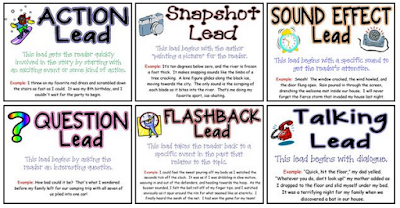Introducing Narrative writing
 |
| (Kieth, K., 2015). Plot Elements. Retrieved from http://bit.ly/1WSTGVE. |
Narrative
writing can be defined as a story based on real or imaginary events that are
linked to a series of sequential actions. This form of writing is quite
commonly seen throughout elementary and is the basis/starting point for
students to develop their writing skills. As students move up in grade, the
length and detail of their stories will most likely increase. As in most
stories, narrative writing must have a beginning (introducing themes/story-line),
middle (description of action, rising action, conflict, climax, falling action),
and end (concluding action/resolution). It must also have the following
elements: plot, characters, and setting. Posters such as the ones displayed below are handy tools to have hanging around the classroom for students to consult throughout the course of the year.
 |
| (Connell, G., 2014). Leads. Retrieved from http://bit.ly/1YAdcda. |
Video Resources
"Focabulary" is a video resource that focuses on the elements of a story. I think that this video would be beneficial to use as an introduction to narrative writing as it is quite catchy. This video would most likely prove to be engaging and the rhythm may help students remember the elements more effectively.
"Focabulary" is a video resource that focuses on the elements of a story. I think that this video would be beneficial to use as an introduction to narrative writing as it is quite catchy. This video would most likely prove to be engaging and the rhythm may help students remember the elements more effectively.
This video is slightly more "low-key" than the previous one as it uses soft music and explores each element more in-depth. I find this resource to provide more information as well as easier for students to follow. When teaching a lesson on narrative writing, I would one of the two videos that I thought would be suitable for my group of students, Presenting both videos to the class is not a terrible idea either, as it is good to review concepts more than once!
Rockin Resources
 |
| (Olivieri, P., 2015). Audience. Retrieved from http://bit.ly/1MoQjRv |
A great resource that focuses on narrative writing is a blog from Pinterest called “Rockin Resources”. This blog is very inviting with its uses of colourful patters and pictures. It also provides links along the side that tie in with writing by grade. The author of this blog Ms. Olivieri (teacher), provides clear step-by-step feedback of how and what she does and then supplements with pictures to show an example of what the step looks like after the processes have been completed. The importance of purpose and audience in regards to narrative writing is also touched upon in this resource. The curtain image displayed below is an example of a structure that Ms. Olivieri uses to remind students to consider why and for whom they are writing for. This structure would be inserted into language notebooks and then the students would fill in the space with their response. I found this to be an engaging method as well as a good opportunity to differentiate instruction (students choose who their audience is).
Student Connection
Through learning the different elements involved in narrative writing and keeping in mind the purpose and audience, students have limitless possibilities to let their creativeness flow. The process of narrative writing not only allows students to pursue topics they are interested in, but also allows them to improve their spelling, sentence structure, punctuation, and so forth. I have witnessed the grade five students at my placement write narratives based on a haunted house (Halloween), and some of the ideas presented in their writing were pretty adventurous to say the least!
 |
(Olivieri, P., 2015). Audience.
Retrieved from http://bit.ly/1MoQjRv
|
Curriculum Connections
I would connect narrative writing with respect to purpose and audience to the grade five curriculum document. It covers the overall expectations "1. generate, gather, and organize ideas and information to write for an intended purpose
and audience and 2. draft and revise their writing, using a variety of informational, literary, and graphic forms
and stylistic elements appropriate for the purpose and audience". It can also be connected to a specific expectation 1.1 which is Purpose and Audience and states that “students will be able to identify the topic, purpose, and audience for a variety of writing forms (e.g., a poem or song on a social issue for performance by the class; a formal letter to the teacher outlining their opinion on eliminating soft drinks from the school vending machine; an article explaining the water cycle and including a flow chart, for an online student encyclopedia)”. For instance students would have to be able to explain the purpose and audience selected as well as demonstrate it through the choice of language used.

No comments:
Post a Comment